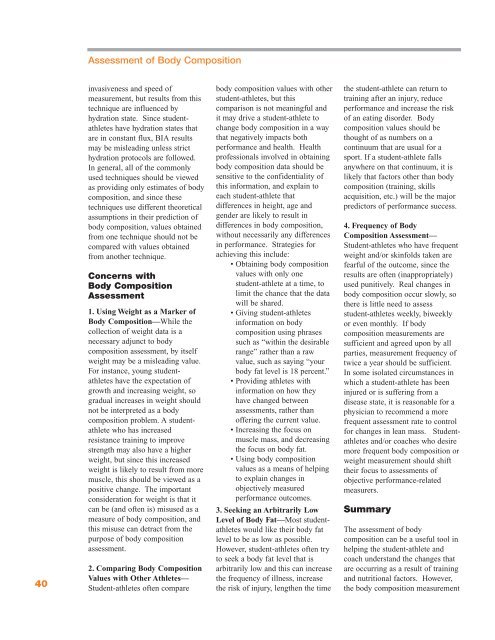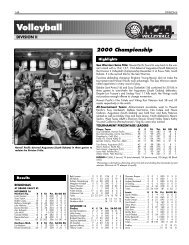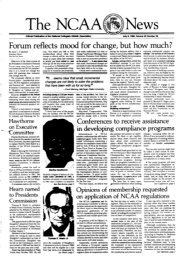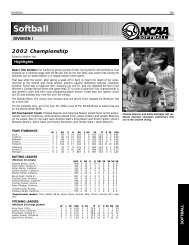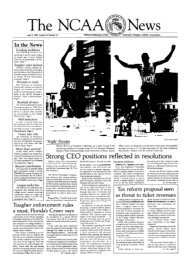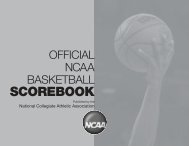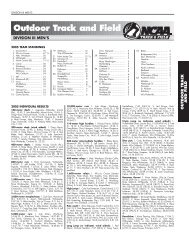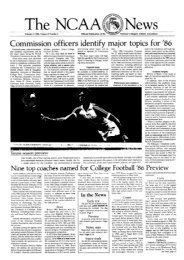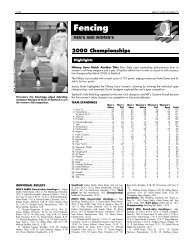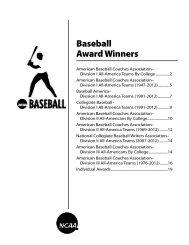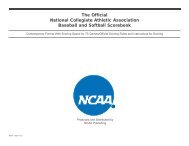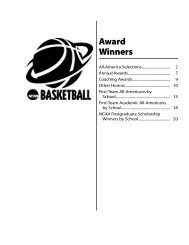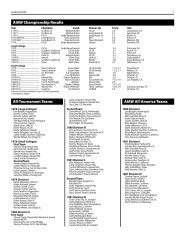Sports Medicine Handbook - NCAA
Sports Medicine Handbook - NCAA
Sports Medicine Handbook - NCAA
You also want an ePaper? Increase the reach of your titles
YUMPU automatically turns print PDFs into web optimized ePapers that Google loves.
40<br />
Assessment of Body Composition<br />
invasiveness and speed of<br />
measurement, but results from this<br />
technique are influenced by<br />
hydration state. Since studentathletes<br />
have hydration states that<br />
are in constant flux, BIA results<br />
may be misleading unless strict<br />
hydration protocols are followed.<br />
In general, all of the commonly<br />
used techniques should be viewed<br />
as providing only estimates of body<br />
composition, and since these<br />
techniques use different theoretical<br />
assumptions in their prediction of<br />
body composition, values obtained<br />
from one technique should not be<br />
compared with values obtained<br />
from another technique.<br />
Concerns with<br />
Body Composition<br />
Assessment<br />
1. Using Weight as a Marker of<br />
Body Composition—While the<br />
collection of weight data is a<br />
necessary adjunct to body<br />
composition assessment, by itself<br />
weight may be a misleading value.<br />
For instance, young studentathletes<br />
have the expectation of<br />
growth and increasing weight, so<br />
gradual increases in weight should<br />
not be interpreted as a body<br />
composition problem. A studentathlete<br />
who has increased<br />
resistance training to improve<br />
strength may also have a higher<br />
weight, but since this increased<br />
weight is likely to result from more<br />
muscle, this should be viewed as a<br />
positive change. The important<br />
consideration for weight is that it<br />
can be (and often is) misused as a<br />
measure of body composition, and<br />
this misuse can detract from the<br />
purpose of body composition<br />
assessment.<br />
2. Comparing Body Composition<br />
Values with Other Athletes—<br />
Student-athletes often compare<br />
body composition values with other<br />
student-athletes, but this<br />
comparison is not meaningful and<br />
it may drive a student-athlete to<br />
change body composition in a way<br />
that negatively impacts both<br />
performance and health. Health<br />
professionals involved in obtaining<br />
body composition data should be<br />
sensitive to the confidentiality of<br />
this information, and explain to<br />
each student-athlete that<br />
differences in height, age and<br />
gender are likely to result in<br />
differences in body composition,<br />
without necessarily any differences<br />
in performance. Strategies for<br />
achieving this include:<br />
• Obtaining body composition<br />
values with only one<br />
student-athlete at a time, to<br />
limit the chance that the data<br />
will be shared.<br />
• Giving student-athletes<br />
information on body<br />
composition using phrases<br />
such as “within the desirable<br />
range” rather than a raw<br />
value, such as saying “your<br />
body fat level is 18 percent.”<br />
• Providing athletes with<br />
information on how they<br />
have changed between<br />
assessments, rather than<br />
offering the current value.<br />
• Increasing the focus on<br />
muscle mass, and decreasing<br />
the focus on body fat.<br />
• Using body composition<br />
values as a means of helping<br />
to explain changes in<br />
objectively measured<br />
performance outcomes.<br />
3. Seeking an Arbitrarily Low<br />
Level of Body Fat—Most studentathletes<br />
would like their body fat<br />
level to be as low as possible.<br />
However, student-athletes often try<br />
to seek a body fat level that is<br />
arbitrarily low and this can increase<br />
the frequency of illness, increase<br />
the risk of injury, lengthen the time<br />
the student-athlete can return to<br />
training after an injury, reduce<br />
performance and increase the risk<br />
of an eating disorder. Body<br />
composition values should be<br />
thought of as numbers on a<br />
continuum that are usual for a<br />
sport. If a student-athlete falls<br />
anywhere on that continuum, it is<br />
likely that factors other than body<br />
composition (training, skills<br />
acquisition, etc.) will be the major<br />
predictors of performance success.<br />
4. Frequency of Body<br />
Composition Assessment—<br />
Student-athletes who have frequent<br />
weight and/or skinfolds taken are<br />
fearful of the outcome, since the<br />
results are often (inappropriately)<br />
used punitively. Real changes in<br />
body composition occur slowly, so<br />
there is little need to assess<br />
student-athletes weekly, biweekly<br />
or even monthly. If body<br />
composition measurements are<br />
sufficient and agreed upon by all<br />
parties, measurement frequency of<br />
twice a year should be sufficient.<br />
In some isolated circumstances in<br />
which a student-athlete has been<br />
injured or is suffering from a<br />
disease state, it is reasonable for a<br />
physician to recommend a more<br />
frequent assessment rate to control<br />
for changes in lean mass. Studentathletes<br />
and/or coaches who desire<br />
more frequent body composition or<br />
weight measurement should shift<br />
their focus to assessments of<br />
objective performance-related<br />
measurers.<br />
Summary<br />
The assessment of body<br />
composition can be a useful tool in<br />
helping the student-athlete and<br />
coach understand the changes that<br />
are occurring as a result of training<br />
and nutritional factors. However,<br />
the body composition measurement


